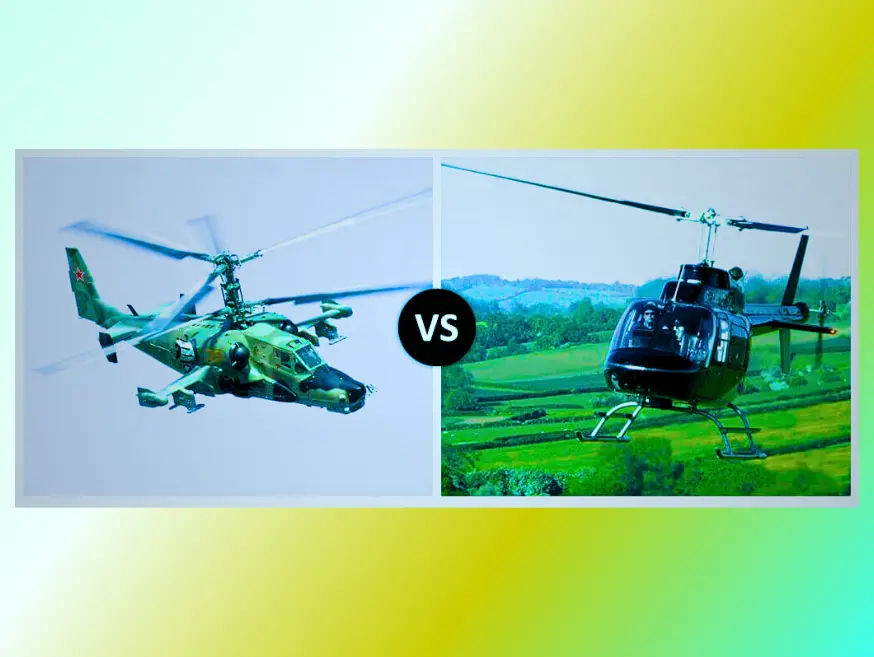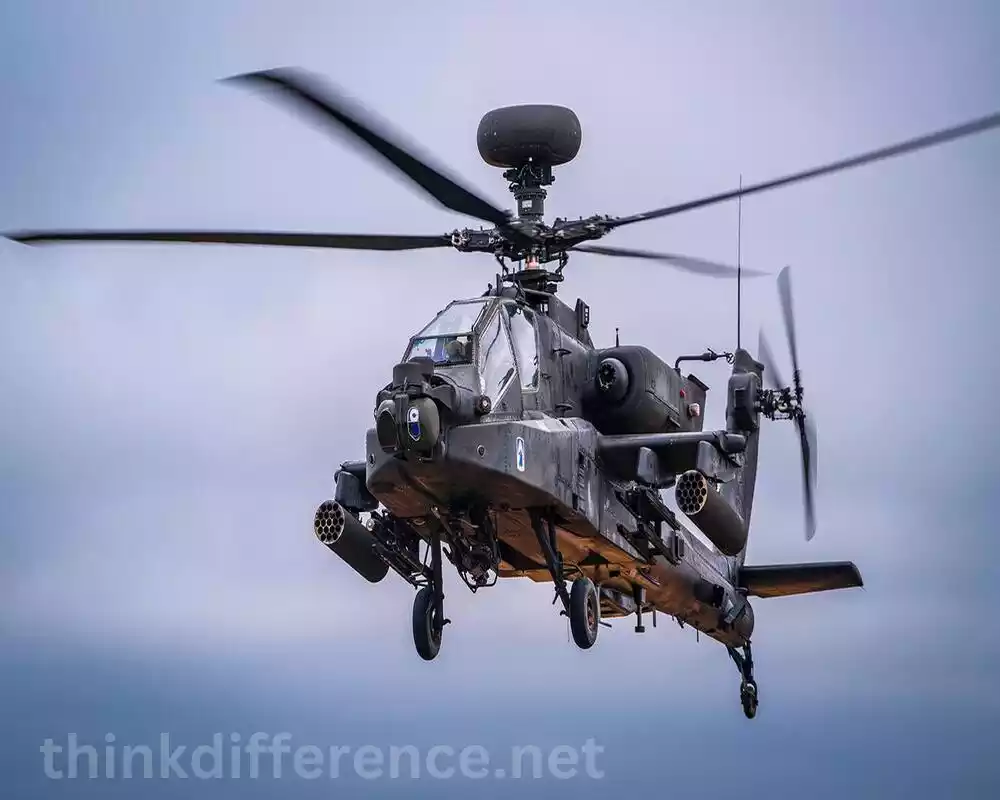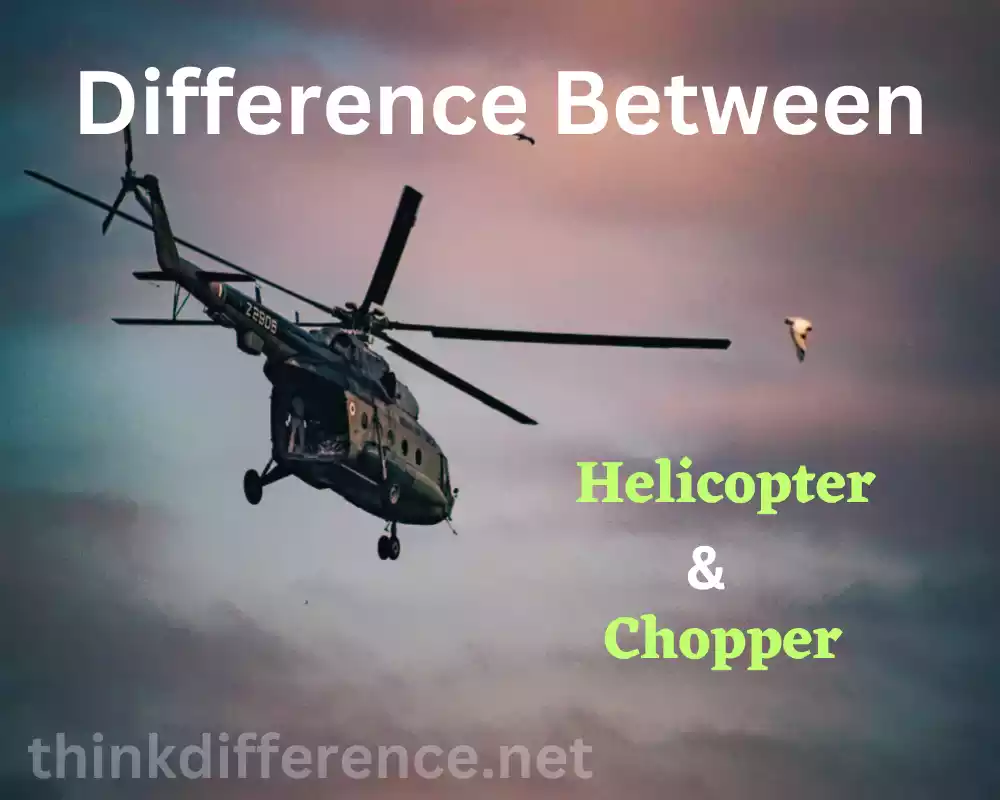Helicopter and Chopper have captured our collective imagination and provided us with an innovative method of traversing the skies with unparalleled versatility. This article will investigate this fascinating technology as well as their various types, applications and security measures.
Definition of Helicopter and Chopper
Helicopter:
Helicopters are aircraft capable of taking off and landing vertically (VTOL), hovering, flying in multiple directions – forwards, backwards, sideways around. Its own axis distinguishable by its vertical take-off/landing capability as well as flight stability features like anti-torque systems to maintain flight stability and keep flying stable during operation.
Helicopters have various applications ranging from transportation, military missions, search-and-rescue missions, medical evacuations, aerial firefighting operations as well as aerial surveys – among many more uses!

Chopper:
Chopper can refer to several things depending on its context; when applied to motorcycles it refers to any modified bike with unique styling that was constructed either entirely from scratch or modified from another motorcycle model. Choppers are known for their unique design elements, such as extended forks, elongated front ends, raked-out front angles, low-slung frames, and often a stripped-down aesthetic. They typically feature high handlebars, a stretched-out chassis, and custom paintwork. Choppers gained popularity in the 1960s and 1970s, primarily associated with the counterculture and motorcycle subculture.
Chopper can also refer to any type of vehicle or machine that has been extensively modified often for aesthetic purposes. For example, chopper bicycles feature similar design elements to chopper motorcycles, with elongated frames, high handlebars, and customized paintwork. Chopper cars are customized automobiles that have undergone significant modifications to alter their appearance and performance.
Chopper refers to any vehicle which has been altered through extensive customization or modification for aesthetic reasons and in order to produce an attractive appearance.
Importance of understanding the difference between Helicopter and Chopper
Understanding the differences between helicopter and chopper for various reasons is extremely essential:
- Safety and Regulations: Helicopters and choppers may have different safety features, regulations, and operational requirements. Pilots, operators, and maintenance personnel must understand these distinctions to comply with safety standards and regulations applicable to each aircraft type. It helps in maintaining the appropriate training, licensing, and maintenance practices for safe operations.
- Functionality and Applications: Knowing the differences between helicopters and choppers helps in understanding their specific capabilities and applications. Helicopters have numerous applications across industries, from transportation and search-and-rescue operations, medical services and military missions, all the way through vertical takeoff/landing capabilities that make these aircraft ideal. On the other hand, choppers, as custom-built motorcycles, have unique purposes, often associated with recreational riding, individual expression, and cultural significance within the biker community.
- Technical Understanding: Helicopters and choppers have distinct design features, aerodynamics, and flight characteristics. Having a grasp of these technical aspects enables enthusiasts, professionals, and aviation enthusiasts to appreciate the engineering behind each type of aircraft. It also helps in understanding how modifications or alterations impact their performance and flight behavior.
- Communication and Terminology: Understanding the difference between helicopters and choppers helps in effective communication within the aviation industry and related communities. It ensures clarity and accuracy when discussing specific aircraft types, operational requirements, or design considerations. Proper terminology usage helps avoid confusion and facilitates better understanding among professionals, enthusiasts, and the general public.
- Historical and Cultural Significance: Helicopters and choppers have distinct historical and cultural significance. Learning about their origins, development, and evolution provides insights into the technological advancements and societal influences that shaped these aircraft. Understanding the cultural associations and symbolism surrounding choppers, particularly in the realm of motorcycle culture and popular media, enriches one’s knowledge of subcultures and their impact on society.
Understanding the difference between helicopters and choppers enhances safety, facilitates effective communication, and allows for a deeper appreciation of their technical aspects, applications, and cultural significance.
Helicopter
Helicopters have the capability of performing vertical takeoff and landing. Helicopters differ from fixed-wing aircraft in that their lift relies on rotating wings or rotors rather than conventional engines to provide lift and propellant.

Their main components include:
- Main Rotor: The main rotor consists of a large horizontal rotor blade or a set of blades that rotate around a vertical mast. The main rotor generates lift by creating a pressure difference between the upper and lower surfaces of the blades, allowing the helicopter to stay airborne.
- Tail Rotor: A tail rotor can usually be found mounted to the tail boom of most helicopters and functions as a small vertical rotor. The tail rotor provides anti-torque control by countering the torque produced by the main rotor’s rotation, ensuring the helicopter remains stable in flight.
- Fuselage: Fuselages form the backbone of a helicopter, housing its cockpit, passenger or cargo compartments and various systems and devices. It is designed to be aerodynamic and structurally strong to withstand flight forces.
- Powerplant: Helicopters are typically powered by one or more engines, which provide the necessary power to rotate the main rotor blades and drive other systems such as the tail rotor and onboard systems.
- Controls: Helicopters have flight controls that enable pilots to maneuver the aircraft in different directions. These controls include cyclic control, collective control, and anti-torque pedals, which allow the pilot to control the pitch, roll, and yaw of the helicopter respectively.
Helicopters offer many advantages. Their maneuverability in tight spaces and slow flight make them suitable for military operations and search and rescue missions. Emergency medical services; aerial firefighters’ missions; transporting goods or passengers and conducting aerial surveys all make use of helicopters more suitable.
Chopper
In the context of vehicles, a “chopper” typically refers to a customized motorcycle that has been modified or built with unique design elements to create a distinct and often eye-catching appearance. Choppers gained popularity in the 1960s and 1970s, particularly within the counterculture and motorcycle subculture.

Here are some key characteristics and features associated with chopper motorcycles:
- Customization: Choppers are extensively customized motorcycles, often created by modifying existing bikes or building them from scratch. The customization process involves altering the frame, suspension, handlebars, and other components to achieve a specific aesthetic and style.
- Long Front End: Choppers are known for their elongated front ends, achieved by extending the forks and creating a more stretched-out appearance. This design element contributes to their distinctive look.
- Raked-Out Front Angles: Choppers typically have a raked-out or extended front fork angle, which gives them a chopper-like profile. This design choice contributes to the bike’s low, elongated stance.
- High Handlebars: Choppers often feature high handlebars, allowing riders to adopt a more relaxed and upright riding position. The handlebars are positioned higher than those found on traditional motorcycles, adding to the unique style.
- Stripped-Down Aesthetic: Choppers often feature minimalistic bodywork, with an emphasis on showcasing the mechanical components of the motorcycle. They may have exposed engines, open frames, and simplified designs.
- Custom Paintwork: Choppers are often adorned with custom paint jobs that can range from vibrant and intricate designs to more minimalist finishes. The paintwork contributes to the overall visual impact of the motorcycle.
- Individuality: Choppers are highly personalized machines, reflecting the creativity and individuality of their owners. Each chopper tends to be unique, reflecting the builder’s personal style and preferences.
Choppers are not limited to motorcycles alone. The term “chopper” can also be used to describe other customized vehicles, such as chopper bicycles or chopper cars, which undergo similar modification processes to achieve a distinctive appearance.
In popular culture, choppers have been featured in movies, television shows, and various forms of media, often associated with rebelliousness, freedom, and a sense of nonconformity. They continue to be celebrated for their artistic design, craftsmanship, and unique expression within the world of motorcycles and customization.
Differences between Helicopter and Chopper
Both terms refer to different things. Let’s compare and contrast them in their various contexts to highlight any distinctions:
Helicopter:
- Design and Function: A helicopter is a type of aircraft that uses rotary wings or rotor blades to generate lift and propulsion. This aircraft can both hover and fly in different directions. The main rotor generates lift, while a tail rotor or anti-torque system counteracts the rotor’s torque.
- Purpose and Applications: Helicopters have many uses, from transportation and military operation, search and Rescue operations and medical evacuation, aerial Firefighting services and aerial surveys. They are utilized in both civilian and military sectors for their versatility and ability to access remote or confined areas.
- Characteristics: Helicopters are typically larger aircraft with enclosed cabins, seating for passengers or cargo compartments, and advanced avionics and systems. They require skilled pilots to handle complex flight controls and maneuvers.
Chopper:
- Design and Customization: A chopper refers to a customized motorcycle or vehicle that has been extensively modified to create a distinctive and unique appearance. Choppers are known for their customized frames, elongated front ends, high handlebars, and stripped-down aesthetic. They often feature custom paintwork and individualized design elements.
- Purpose and Style: Choppers are primarily designed for aesthetic appeal and personal expression. They are associated with the motorcycle subculture and are often seen as symbols of rebellion, freedom, and individuality. Choppers prioritize style over practicality and may sacrifice some functional aspects for their unique look.
- Characteristics: Choppers can vary greatly in terms of size, engine type, and construction. They typically have elongated front forks, extended frames, and modified handlebars to achieve a low and stretched-out profile. Chopper motorcycles may feature custom paint, high-performance engines, and customized components.
The main differences between helicopters and choppers lie in their contexts and purposes. Helicopters are aircraft used for transportation and various applications, featuring advanced technology, complex flight controls, and versatile capabilities. On the other hand, choppers refer to customized motorcycles or vehicles, primarily focused on unique aesthetics and personal expression, with modifications aimed at creating a distinct appearance rather than functional enhancements.
Similarities of Helicopter and Chopper
While helicopters and choppers differ in their specific contexts and purposes, they also share some similarities.
Here are a few key similarities between helicopters and choppers:
- Customization: Both helicopters and choppers can undergo customization to achieve a unique appearance or meet specific requirements. Helicopters used in specialized operations, such as law enforcement or medical services, may undergo modifications to accommodate specific equipment or systems. Choppers, as customized motorcycles or vehicles, undergo extensive modifications to create a distinct and personalized look.
- Individuality and Style: Both helicopters and choppers are often associated with individuality and style. Helicopters can be painted with custom liveries or markings, allowing them to stand out and reflect the operator’s identity. Similarly, choppers are customized to express the owner’s personal taste and style, reflecting their unique preferences and creativity.
- Artistic Expression: Helicopters and choppers provide a platform for artistic expression. Helicopters can be used as canvases for custom paintwork, creating visually striking designs and artwork. Choppers, with their customized frames, paint jobs, and design elements, showcase the artistic vision and craftsmanship of their builders.
- Popularity and Cultural Significance: Both helicopters and choppers have captured public interest and hold cultural significance. Helicopters are often featured in movies, television shows, and documentaries, portraying their impressive capabilities and evoking a sense of adventure and excitement. Choppers, especially within the motorcycle subculture, have become iconic symbols of rebellion, freedom, and self-expression.
While helicopters and choppers may differ in their primary functions and overall contexts, these shared similarities highlight the role of customization, individuality, artistic expression, and cultural significance within both realms.
Future Trends in Helicopter and Chopper Technology
Future trends should focus on performance, efficiency and safety. Here are a few areas for development which should be investigated:
- Electric and Hybrid Propulsion: Electric and hybrid propulsion for helicopters has seen increasing success, enabled by advances in battery and motor technologies. Electric or hybrid propulsion can significantly decrease emissions, noise pollution and operating costs while simultaneously improving energy efficiency and increasing energy savings.
- Autonomous and Unmanned Capabilities: Integrating autonomous with non-manned systems will likely play a vital role in Rotorcraft Technology’s future success, including developing autonomous flight capabilities such as advanced flight control algorithms and artificial intelligence algorithms that allow helicopters and choppers to complete certain tasks without human assistance; unmanned aerial vehicles like drones (which include autonomous chopper designs) should become increasingly prevalent for various uses.
- Advanced Structures and Materials: Helicopter and chopper manufacturers will continue using advanced materials like lightweight alloys and composites in their construction, which possess improved strength-to-weight ratios that enhance performance, fuel efficiency, durability, etc. Advanced structural designs and manufacturing techniques can enhance aerodynamics, reduce vibrations, and increase safety.
- Noise Reduction: Noise reduction is a crucial area of focus to mitigate the impact of helicopters and choppers on the environment and communities. Ongoing research aims to develop quieter rotor systems, innovative soundproofing technologies, and improved aerodynamics to reduce noise emissions during flight operations.
- Aerodynamic Improvements: Advancements in aerodynamics will contribute to improved efficiency and performance. Innovations in rotor designs, such as variable-pitch or active blade control systems, can enhance lift, reduce drag, and improve maneuverability. Streamlined fuselage designs, including modifications to reduce aerodynamic drag and turbulence, are also being explored.
- Enhanced Safety Systems: Safety enhancements will continue to be a priority in rotorcraft technology. This includes the development of advanced avionics systems, collision avoidance technologies, and improved pilot assistance systems. Increased automation and integration of sensors can assist pilots in navigation, obstacle detection, and emergency situations.
- Connectivity and Data Integration: The integration of advanced connectivity and data systems will play a significant role in future rotorcraft technology. This includes enhanced communication capabilities, real-time data exchange, and integration with ground control systems. Improved data collection and analysis can enable predictive maintenance, optimize flight operations, and enhance overall safety and efficiency.
These trends represent potential directions in the development of helicopter and chopper technology. The specific advancements and implementation may vary based on technological breakthroughs, regulatory considerations, and market demands.
Limitations and Challenges
While Helicopter and Chopper technology continue to advance, there are several limitations and challenges that researchers, engineers, and industry professionals face.
Some of these limitations and challenges include:
- Range and Endurance: Helicopters and choppers generally have limited range and endurance compared to fixed-wing aircraft. This is due to factors such as fuel consumption, payload restrictions, and the need for frequent maintenance and refueling. Extending the range and endurance of rotorcraft remains a challenge, especially for long-distance or extended-duration missions.
- Speed and Efficiency: Rotorcraft, in general, are slower and less fuel-efficient than fixed-wing aircraft. The inherent design of rotor systems, including drag and rotor inefficiencies, can limit the maximum speed achievable. Improving speed and efficiency while maintaining safety and maneuverability is an ongoing challenge for helicopter and chopper technology.
- Noise and Environmental Impact: Helicopters and choppers are known for their high noise levels, which can be disruptive to communities and restrict their use in urban areas. Reducing noise emissions while maintaining performance is a challenge that requires innovative rotor designs, advanced soundproofing materials, and noise reduction technologies. Additionally, addressing the environmental impact, such as reducing emissions and improving fuel efficiency, is a priority for sustainable rotorcraft technology.
- Cost and Accessibility: Helicopters and customized choppers can be costly to purchase, operate, and maintain. The high costs associated with these aircraft limit their accessibility to certain industries and individuals. Finding ways to reduce manufacturing and operational costs while maintaining safety and performance is a challenge. Improving accessibility to rotorcraft technology in terms of affordability and availability is a consideration for wider adoption and utilization.
- Pilot Workload and Automation: Operating helicopters and choppers requires skilled pilots who manage complex flight controls and systems. The workload on pilots can be demanding, especially during critical phases of flight or challenging environmental conditions. Advancing automation technologies and reducing pilot workload while maintaining safety remains a challenge.
- Safety and Reliability: Safety is a paramount concern in rotorcraft operations. Enhancing safety systems, improving reliability, and reducing the risk of accidents or failures are ongoing challenges. This includes developing advanced avionics, enhancing pilot training and situational awareness, and implementing effective maintenance and inspection practices.
- Regulatory and Certification Requirements: Helicopter and chopper technology are subject to strict regulatory and certification processes to ensure airworthiness and compliance with safety standards. Meeting these requirements and obtaining necessary certifications can be time-consuming, costly, and pose challenges for new technological advancements and innovations.
Addressing these limitations and challenges requires continuous research, innovation, collaboration between industry and regulatory bodies, and a focus on safety, efficiency, and sustainability. Overcoming these challenges will drive the future development and utilization of helicopter and chopper technology.
Conclusion
Helicopters and choppers have transformed the way we perceive aviation. From their early beginnings as sketches in the notebooks of visionaries to the cutting-edge machines of today, these rotary-wing aircraft continue to serve humanity in countless ways. As technology evolves, the sky is the limit for the future of vertical flight.



